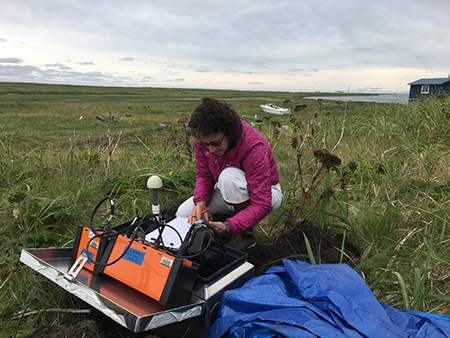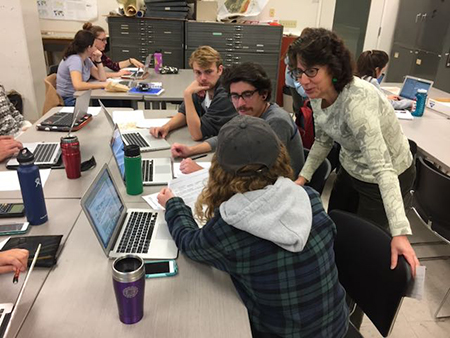Campus News
UCSC Earth and planetary sciences professor reflects on 35 years at UC Santa Cruz
After a very rewarding career at UC Santa Cruz, Susan Schwartz is retiring.



Around 100 UC Santa Cruz staff and faculty retire each year. Please join us in celebrating the next chapter of their lives. If you or someone you know is retiring and would like to be included on the Welcome to Retirement page information can be submitted to the Retiree & Emeriti Center at rec@ucsc.edu.
Susan Schwartz, Professor of Earth and Planetary Sciences at UC Santa Cruz, is retiring on July 1 after 35 years at the university. In her position, she had three primary responsibilities—teaching, research, and service—and she devoted herself to all of these.
Teaching and Research
“Nothing I do in my job is more exciting or rewarding than helping a student discover a new passion,” says Professor Schwartz. “This can be getting an undergraduate student in a class for non-majors excited enough about geology that they decide to make it their major, or guiding a nascent graduate student researcher in a direction that helps them uncover something new about how the Earth works. The sense of excitement they feel about discovering something new feeds their curiosity, and their desire to know more fuels new investigations in new directions.”
During Schwartz’s career, many graduate students accompanied her on field projects, many of whom have continued to pursue fieldwork in their careers. She greatly enjoyed going into the field to conduct research. Much of this involved collecting seismic data in various locations including Antarctica, Alaska, Costa Rica, New Zealand—and of course, California.
Schwartz is very proud of the successes and accomplishments of graduate students she advised and worked with over the years.
“So many have gone on to do creative, important, and interesting work, and I am gratified to know that I may have played some part in starting them off on their paths. I am proud of the rapport that I had and still have with most of these former students and the mutual respect and admiration that exists between us. They have trained and advised another generation of scientists, and I am delighted to follow their accomplishments as well.”
Classroom teaching was a big part of Schwartz’s career. She taught several classes for EPS majors and graduate students and educated more than 5,000 students over the last 30 years in a large non-major course called “Geology of National Parks.” She frequently runs into students from this class around town. Many tell her how their experience visiting a National Park was enriched through her class.
“This is exactly the primary learning goal I set for this course,” she says. “I can think of nothing more important than helping to impart knowledge that is able to change a student’s perspective and enrich their life experience.”
During her career at UCSC, Schwartz had a lot of roles in addition to being a professor. She served as the Director of the Keck Seismology Laboratory, the Director of the Center for the Study of Imaging and Dynamics of the Earth (CSIDE), as a graduate advisor for the EPS department, taught in the COSMOS summer program, and served on many Academic Senate Committees. She also chaired the Committee on Career Advising (CCA) and served as the UCSC representative to the UC systemwide Senate Assembly.
Costa Rica Earthquake Research
Schwartz started investigating earthquake behavior at the northern Costa Rica subduction zone when she first arrived at UCSC. She continued working in Costa Rica on this topic throughout her entire career. With both US and Costa Rican colleagues, Schwartz and a team installed and operated a network of seismic and GPS stations that collected data in Costa Rica for several decades. In 2012, a large earthquake occurred within that network.
“Having made observations during this earthquake, as well as many years before and after, allowed us to construct models of where strain was accumulating prior to the earthquake and where slip occurred during and immediately after the earthquake,” she says. “Our work provided some of the clearest evidence at that time that regions along a fault that are building up strain closely outline the areas that will slip during the next large earthquake. This understanding of strain accumulation and release in coastal regions of subduction zones is of fundamental importance and has improved our ability to forecast the size and location of future subduction zone earthquakes and tsunamis.”
Loma Prieta Earthquake & Effects on Career
After earning a B.S. in geophysics from Brown University and a Ph.D. in seismology from the University of Michigan, Schwartz came to UCSC in 1988 as a UC President’s postdoctoral fellow. She spent two years as a fellow and then four years as a researcher at the Institute of Tectonics (the predecessor of CSIDE, mentioned earlier) before she joined UCSC’s faculty in 1994.
The 1989 Loma Prieta earthquake occurred while she was a postdoctoral fellow. This influenced her desire to continue to work at UCSC. “Following this event, there were a lot of collaborations with colleagues,” says Schwartz. “The proximity to so many other institutions engaged in seismology was great. It made sense to do that kind of work in California where a major active fault existed in my backyard.”
Field seismology dominated much of her future research. “I got to install and operate what at the time was cutting-edge portable digital seismic instrumentation to record the aftershocks of the Loma Prieta earthquake. While traveling around in the epicentral region of the earthquake I saw, close up, the devastating aftermath of a large earthquake and the effects it had on people’s lives. In the community that I lived in, several people died, and thousands were left homeless and had to live in shelters. This experience remained with me for my entire career and infused my future earthquake research with an important human element.”
Schwartz encourages everyone to be prepared for an earthquake (including having emergency supplies on hand and ensuring there are no unsecured bookcases or other hazards in their environment).
Gratitude for UCSC
Schwartz loves the physical environment of the UCSC campus. “Anytime I get frustrated with a particular task or feel badly about something, I take a walk around the campus, smell the redwoods, listen to the birds, and that sense of frustration usually melts away. After a campus walk, I return to my office refreshed and ready to take on the world!”
She credits the collegiality of the Earth and Planetary Sciences department for making her time at UCSC especially fantastic. “When I arrived 35 years ago, I quickly learned the tenor of the department: it was cooperative, accepting, and very welcoming. What a fabulous place for me to land directly out of my Ph.D.,” she says. “In 35 years, faculty have come and gone, but the ambiance of the department that the early faculty established has remained. It’s a great place to work, it’s highly collaborative, and there is an excellent department rapport. Everyone wants the best for their colleagues and are willing to put skin in the game to help achieve it.”
Schwartz extends words of appreciation to many folks she met along the way:
I want to thank Marino Protti, my first Ph.D. student, for getting me interested in earthquakes and volcanoes in Costa Rica and for being my colleague in these studies for 35 years,” she says. “The UCSC seismology lab has been a great place to work. I have learned so much from my colleagues, Thorne Lay, Emily Brodsky, and Heather Savage, and all the postdocs, graduate students, undergraduates, and visiting scientists who have spent time there. So many great discoveries and so much fun!”
Final Thoughts Heading into Retirement
64-year-old Schwartz looks forward to retirement. “I plan to travel a lot without my computer,” she says. “I like walking and biking trips and already have a biking trip to Portugal with friends planned for this fall.” She also hopes to do some volunteer work.
As she retires, Schwartz is comfortable knowing that her EPS department colleagues working on earthquakes will undoubtedly make “some very exciting discoveries improving our basic understanding of earthquake occurrence and advancing our earthquake forecasting abilities. UCSC has been extremely strong in earthquake research, and even with my and Thorne Lay’s retirement, it will remain so!”
She notes that the retirement of two earthquake research faculty will, however, make an impact. To assure that the UCSC seismology lab remains an intellectually vibrant and world-class institution, the EPS Department established a “Seismo Visitor Fund” to support outside earthquake researchers to visit UCSC to give talks and collaborate with students and researchers. Anyone who wishes to contribute to the Seismo Visitors Fund can do so through connect.ucsc.edu/seismo.